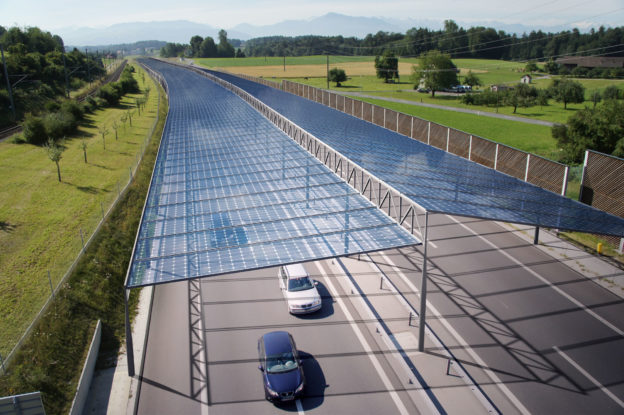
We have learnt from past experience that transforming road surfaces into solar panels perhaps is not the optimal green solution as both the bustling traffic and the substantial amount of dust will impact the performance of solar power generation. So what if the solar panels are installed above the driveway? German and Austrian scientists are recently pondering on how to utilize the highway section that occupies 2.6% of the total area in Germany by transforming the transportation network into a section of green power supply.
The German and Austrian scientists have unfolded a 3-year highway solar program that explores if solar panels can be installed on the canopy established on highway. The theory is basically attainable, as Germany has a 13,000km long highway network, and if a standard 4-lane highway measures 24m in width is established with solar panels that are capable of 180W/m2, the total solar capacity can reach to 56GW, which exceeds the accumulated installed capacity of 49GW in Germany during 2019.
Martin Heinrich, supervisor of the solar module product team from the Fraunhofer Institute for Solar Energy Systems (ISE), commented that this approach is able to generate 47TWh of clean power each year. Looking at the power consumption demand from Germany in 2019, the solar highway will satisfy 9% of power consumption in the country, equaling approximately 1/3 of household power consumption.
However, solar panels cannot be installed in all places, since a highway consists of tunnels, areas below bridges, and areas with shades. Heinrich believes the priority right now is to implement evaluation.
Researchers will continue to work with traffic engineering company Foster Industrietechnik in the future on studying if solar canopy is able to elevate the defensive capacity of highways. Heinrich commented that canopy reduces accumulated rain water, snow, and frost, and if the canopy is elevated on roads, the solar panels above can also exert their capabilities and convert sunlight directly.
Researchers are planning to unfold the demonstration program in Southern Germany, including the 1-year testing at the section 20-40m from the exit and entrance, where they will not only study the power generation volume, but also observe on water drainage, snow and wind resistance, stability, and resistance to vehicle collision, since equipment maintenance and traffic security are the largest challenge subsequent to the completion of engineering.
However, it is rather expensive to install solar panels above highways. The cost is roughly equivalent to or larger than residential solar in Germany, where each m2 costs EU€300, and is way more expensive than ground solar at EU€125.
There are multiple solar highways in the world. The local government of Jinan from Shandong Province in China had previously laid 1,080m of solar sections on a highway where over 45K units of vehicles drive pass every day in order to reduce carbon and preserve space, and the solar power is able to provide electricity to the highway equipment.
The Directorate-General for Public Works and Water Management is also considering to install solar panels on the A37 motorway in Drenthe that are expected to be 40km, and 3 km2 (approx. 300 hectares) in total area. The solar panels will not be laid on the road, but on the refuge islands and enclosures between roads, and will arrive at 140MW in total installed capacity.
(Cover photo is a sketch, source: labor3)







